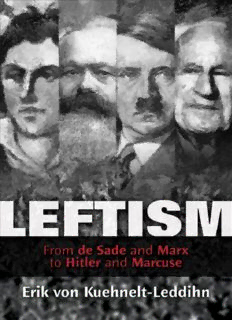
Leftism: from de Sade and Marx to Hitler and Marcuse PDF
Preview Leftism: from de Sade and Marx to Hitler and Marcuse
LEFTISM From de Sade and Marx to Hitler and Marcuse ERIK VON KUEHNELT-LEDDIHN RLINGTON HOUSE·PUBLISHERS NEW ROCHELLE, NEW YORK To the Noble Memory of Armand Tuffin, Marquis de la Rouërie Courageous Fighter for Liberty Ardent Admirer of America Bitter Foe of the Jacobins Friend of George Washington Member of the Order of the Cincinnati Copyright© 1974 Arlington House All rights reserved. No portion of this book may be reproduced without written permission from the publisher, except by a reviewer who may quote brief passages in connection with a review. Library of Congress Cataloging in Publication Data Kuehnelt-Leddihn, Erik Maria, Ritter von, 1909– Leftism: from de Sade and Marx to Hitler and Marcuse. Includes bibliographical references. 1. Liberalism—History. 2. Democracy—History. 3. Conservation—History. 4. Political science— History. I. Title. JC571.K79 320.5′1′09 73-78656 ISBN 0-87000-143-4 Manufactured in the United States of America Contents Preface Introduction Part I. The Leftist Mind 1. Identity and Diversity 2. Equality and Liberty 3. Democracy and Liberalism 4. Right and Left Part II. Leftism In History 5. The Historic Origins of Leftism 6. Nascent America 7. The French Revolution 8. From Democracy to Romantic Socialism 9. From Romantic to Scientific and International Socialism 10. From Socialism to Communism 11. From Marxism to Fascist Nationalism 12. National Socialism and Socialist Racism Part III. Liberalism 13. Real Liberalism 14. False Liberalism Part IV. The Left and U.S. Foreign Policy 15. The American Left and World War I 16. Leftism Goes from War to War 17. Another Leftist War Part V. Leftism Today 18. Anticolonialism 19. The New Left 20. Conservatives and Liberals 21. The Outlook Right and Left in State, Society, Church, Economy and Daily Life Appendix Notes Index to Text and Notes Preface The author of this tome thinks that he owes it to his readers to declare his baggage, to say a few words about the purpose of this book as well as about himself. I am an Austrian with a rather varied background and a good share of unusual experiences. Born in 1909 as the son of a scientist (radium and X-ray) who died as a victim of his research work, I traveled quite a bit as a young boy and acquired a knowledge of several tongues. Today I read twenty languages with widely varying skill and speak eight. At the age of sixteen I was the Vienna correspondent of the Spectator (London), a distinguished weekly founded by Addison and Steele. Engaged in the study of law and Eastern European history at Vienna University at the age of eighteen, I transferred a year later to the University of Budapest (M.A. in Economics, Doctorate in Political Science). Subsequently I embarked on the study of theology in Vienna, but went to England in 1935 to become Master at Beaumont College and thereafter professor at the Georgetown Graduate School of Foreign Service from 1937 to 1938. I was appointed head of the History Department in St. Peter’s College, Jersey City (1938-1943) and lecturer in Japanese at Fordham University. Until 1947 I taught at Chestnut Hill College, Philadelphia. These studies and appointments were interspersed with extensive travels and research projects, including the USSR as early as 1930–1931. During my years in America I traveled in every state: Only southeastern Oregon and northern Michigan alone are still my “blank spots.” In 1947 I returned to Europe and settled in the Tyrol, halfway between Paris and Vienna, and between Rome and Berlin, convinced that I had to choose between teaching and research. From 1949 onward I revisited the United States on annual lecture tours. Since 1957 I have traveled every year either around the world or south of the Equator. One of my ambitions is to know the world; another one is to do research in arbitrarily chosen domains serving the coordination of the various branches of the humanities: theology, political science, psychology, sociology, human geography, history, ethnology, philosophy, art. I have a real horror of one-sided, permanent specialization. I am also active as a novelist and painter. My books, essays, and articles have been published on five continents and in twenty-one countries. Introduction So much about myself. The purpose of this book is to show the character of leftism and to what extent and in what way the vast majority of the leftist ideologies now dominating or threatening most of the modern world are competitors rather than enemies. This, we think, is an important distinction. Shoe factory A is a competitor of shoe factory B, but a movement promoting the abolition of footwear for the sake of health is the enemy of both. In the political field today this distinction, unfortunately, is less obvious and largely obscured by a confusion in semantics. This particular situation is bad enough in Europe, but it is even worse in the United States. This state of affairs, in turn, has adversely influenced the foreign policy of the United States which in the past and in the present not only has been determined by what—really or only seemingly—is America’s self-interest, but also by ideological prejudices. Very often these ideological convictions coloring the outlook, the aims, the policies of those Americans responsible for the course of foreign affairs (not only Presidents, cabinet members, or congressmen, but also professors, radio commentators and journalists), have actually run counter to America’s best interest as well as to the very interest of mankind. There is no reason to believe that ideologies—i.e., coherent political-social philosophies, with or without a religious background—have come into play in America only during this century when America was engaged in two crusades under two Democratic administrations. Nor do we subscribe to the opinion so
Description: